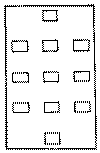By Dan Beard

Fig. 268.
Brick Skittles.
Because some people used nine-pins as a gambling game, authorities thought to stamp out the evil by making the game unlawful. But after the law against nine-pins was passed the proprietors of the bowling alleys hung out signs "Ten-pins played here," and as the law said nothing about ten-pins the authorities were unable to interfere. Ten-pins thus became the American game. At first all games with balls and pins as bowls and skittles were out-door games and played on smooth, level grass-plots similar to the old Bowling Green in New York City.
Skittles
is an old English name for wooden pins and the game in which they were used. The game of
Bowls

Fig. 269.
American Bowls.
was like a game of marbles, with this difference, that in place of shooting a small marble from the fingers a large wooden ball was rolled at a number of other wooden balls placed some distance away on the green.
British Skittles
British skittles is a game allied in character to bowls. In the last century skittles was a fashionable game. An old print of 1786 represents a skittle-alley of that period. The alley is fringed with poplars, and has at one end a summer-house. Here three gentlemen in cocked hats read the news and partake of refreshments. More refreshments are carried by a waiter. Old-fashioned "dudes" in cocked hats look on, while a friend rolls a ball at the pins. The moral is :
"In Reason's Eye the world's a Skittle Ground In which mankind will tott'ring pins be found."
Skittles in China and Persia
The book which is adorned with these reflections is a complete guide to "Old and New Methods of Forming General Goes and Tips," and includes a discourse on the Chinese and Persian modes of playing skittles. From this it appears that skittles in olden times was considered a most scientific affair. The frame (the name of the arrangement of pins) and other features of the game were all calculated on mathematical principles, with arcs and curves and plenty of goodly learning.
The Chinese use twenty-five pins, and the game counts 457 points. The different pins are called Tong-hw, Tsi-shu, Nang-Mw, etc., and refer to the resemblance between the standing pins and a wood or forest. The Persians set up the pins in concentric circles-that is, one circle inside another circle-and use seventeen pins. The ball was like that used in English bowls.
Such are the rude outlines of British and foreign skittles; but mastery of the details of the game can be acquired only by special aptitude and serious application, and is hardly to be attained by an American boy, who has so many equally good games at hand. According to an old English book of games, skittles proper is what we call nine-pins.
Brick Skittles
Ordinary bricks, or, as the Ohio boys call them, " brick bats," make good skittles, and cobble-stones will make very fair bowls for a game. On a vacant lot or open space draw a diamond-shaped figure and set up three rows of bricks at equal distances from each other. At a distance agreed upon from this "frame" draw the scratch or taw- line, and with your cobble-stones or small bowlders bowl the bricks down as you would the pins in a bowling-alley. Count a point for every brick fairly upset. Make the game as many points as you wish, and take turns in bowling.
Fours

Fig. 270.
Frame of Four Bricks.
is played in the same way as nine-pins or skittles, with the exception that bricks are used for nine-pins, and that only four bricks are set up in the frame, one at each of the four corners of the diamond.
Dutch Pins.

Fig. 271.
Dutch Pins.
In the real game of Dutch pins the skittles are larger and taller than in the other games here described, but as bricks are made of one size you will use the same bricks for Dutch pins that you do for nine-pins, but a square is used in place of a diamond for the frame, and nine bricks are set up in three lines.